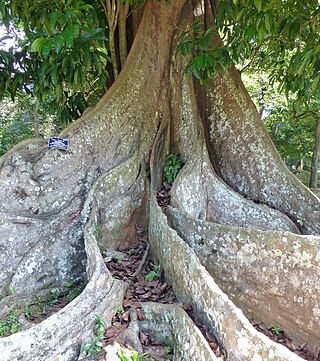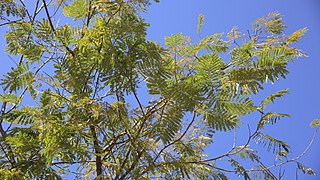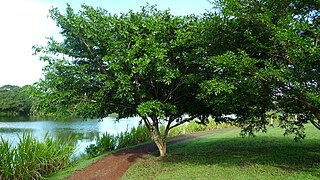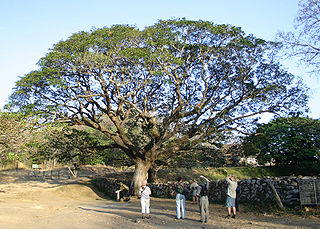
The Mimosoideae are a traditional subfamily of trees, herbs, lianas, and shrubs in the pea family (Fabaceae) that mostly grow in tropical and subtropical climates. They are typically characterized by having radially symmetric flowers, with petals that are twice divided (valvate) in bud and with numerous showy, prominent stamens.

Cassia is a genus of flowering plants in the legume family, Fabaceae, and the subfamily Caesalpinioideae. Species are known commonly as cassias. The genus includes 37 species and has a pantropical distribution. Species of the genera Senna and Chamaecrista were previously included in Cassia. Cassia now generally includes the largest species of the legume subtribe Cassiinae, usually mid-sized to tall trees.

Mora is a genus of large trees in the subfamily Caesalpinioideae of the legume family Fabaceae,.

Calliandra is a genus of flowering plants in the pea family, Fabaceae, in the mimosoid clade of the subfamily Caesalpinioideae. It contains about 140 species that are native to tropical and subtropical regions of the Americas.

Senna, the sennas, is a large genus of flowering plants in the legume family. This diverse genus is native throughout the tropics, with a small number of species in temperate regions. The number of species is estimated to be from about 260 to 350. The type species for the genus is Senna alexandrina. About 50 species of Senna are known in cultivation.

Chloroleucon is a genus of flowering plants in the family Fabaceae. It contains 11 species native to the tropical Americas, ranging from Mexico through Central America, the Caribbean, and South America to northern Argentina. Some authorities consider it part of the genus Albizia. Its name is derived from the Greek words χλωρóς (chloros), meaning "green," and λευκός (leukos), meaning "white."

Cojoba is a genus of flowering plants in the family Fabaceae. There are 37 described species, of which 20 are accepted This genus can be found in South America.

Dimorphandra is a genus of legume in the family Fabaceae, subfamily Caesalpinioideae. It includes 26 species native to northern South America, ranging from Colombia and Venezuela to Bolivia, Paraguay, and southeastern Brazil.
Hydrochorea is a genus of flowering plants in the family Fabaceae. It includes 11 species native to Central and South America and west and west-central Africa. It belongs to the mimosoid clade of the subfamily Caesalpinioideae.

Leucochloron is a genus of flowering plant in the family Fabaceae. It includes four species native to Brazil. It belongs to the mimosoid clade of the subfamily Caesalpinioideae.

Macrolobium is a legume genus in the subfamily Detarioideae. It is a tropical genus with about 80 species. Half occur in Brazil, where they are common in the floodplains of the Amazonian Basin. Members of the genus are used as ornamentals and for their wood.

Pithecellobium is a genus of flowering plants in the family Fabaceae. It includes approximately 23 species from the tropical Americas, ranging from Mexico to Peru and northern Brazil, including the Caribbean Islands and Florida.

Zygia is a genus of flowering plants in the family Fabaceae. It belongs to the mimosoid clade of the subfamily Caesalpinioideae.
Blanchetiodendron is a genus of flowering plants in the family Fabaceae. It belongs to the mimosoid clade of the subfamily Caesalpinioideae. It contains a single species, Blanchetiodendron blanchetii, a shrub endemic to eastern Brazil. It ranges from Bahia to northeastern Minas Gerais states.

Havardia is a genus of flowering plants in the family Fabaceae. It belongs to the mimosoid clade of the subfamily Caesalpinioideae. It includes five species of trees native to the Americas, ranging from Texas and northern Mexico through Central America to Colombia and Venezuela. Typical habitats include warm-temperate and tropical seasonally-dry woodland, wooded grassland, and desert thorn scrub, typically below 450 meters elevation.

Samanea is a genus of flowering plants in the family Fabaceae. It belongs to the mimosoid clade of the subfamily Caesalpinioideae. The type species is Samanea saman from South America.

Schnella is a genus of flowering plants in the legume family, Fabaceae. It belongs to the subfamily Cercidoideae. All of its species are neotropical lianas.

Jupunba is a genus in the family Fabaceae. It is native to region from South Mexico extending to tropical America.
Pseudalbizzia is a genus of flowering plants in the pea family (Fabaceae). It includes 17 species which are native to the tropical Americas, from Mexico to northern Argentina.
















